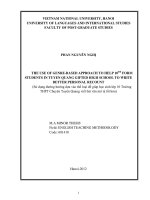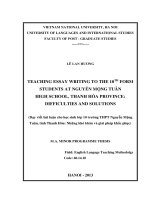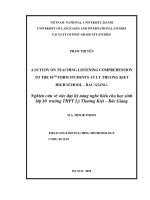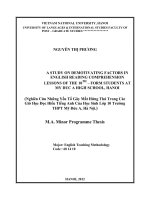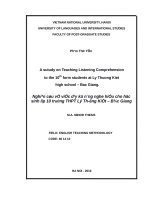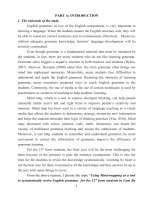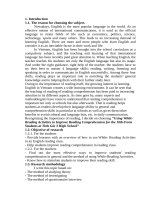The use of genre-based approach to 10th form students in Tuyen Quang gifted high school to write better personal recount = Sử dụng đường hướng dựa vào thể loại
Bạn đang xem bản rút gọn của tài liệu. Xem và tải ngay bản đầy đủ của tài liệu tại đây (561.67 KB, 47 trang )
1
VIETNAM NATIONAL UNIVERSITY, HANOI
UNIVERSITY OF LANGUAGES AND INTERNATIONAL STUDIES
FACULTY OF POST-GRADUATE STUDIES
PHAN NGUYÊN NGHỊ
THE USE OF GENRE-BASED APPROACH TO HELP 10
TH
FORM
STUDENTS IN TUYEN QUANG GIFTED HIGH SCHOOL TO WRITE
BETTER PERSONAL RECOUNT
(Sử dụng đường hướng dựa vào thể loại để giúp học sinh lớp 10 Trường
THPT Chuyên Tuyên Quang viết bài văn mô tả tốt hơn)
M.A MINOR THESIS
Field: ENGLISH TEACHING METHODOLODY
Code: 601410
Hanoi-2012
2
VIETNAM NATIONAL UNIVERSITY, HANOI
UNIVERSITY OF LANGUAGES AND INTERNATIONAL STUDIES
FACULTY OF POST-GRADUATE STUDIES
PHAN NGUYÊN NGHỊ
THE USE OF GENRE-BASED APPROACH TO HELP 10
TH
FORM
STUDENTS IN TUYEN QUANG GIFTED HIGH SCHOOL TO WRITE
BETTER PERSONAL RECOUNT
(Sử dụng đường hướng dựa vào thể loại để giúp học sinh lớp 10 Trường
THPT Chuyên Tuyên Quang viết bài văn mô tả tốt hơn)
M.A MINOR THESIS
Field: ENGLISH TEACHING METHODOLODY
Code: 601410
Supervisor: ĐỖ BÁ QUÝ, M.Ed.
Hanoi-2012
6
TABLE OF CONTENTS
CONTENTS
PAGE
ACKNOWLEDGMENTS
i
ABSTRACT
ii
TABLE OF CONTENTS
iii-iv
LIST OF TABLES AND FIGURES
vi
PART A: INTRODUCTION
1. Rationale and theoretical backgrounds of the study
1-3
2. Aims of the study
3-4
3. The study questions
4
4. Scope of study
4
5. Design of the study
4-5
PART B: DEVELOPMENT
Chapter 1: Literature review
1. Genre
6
2. Recount
6-7
3. Types of recount
7
4. Personal recount
7
7
5. Genre-based approach
7-13
6. Benefits and Limitations of Genre based approach to teaching writing
13-15
Chapter 2:Methodology and research schedule
2.1. Independent and Dependent Variables
16
2.2. Research design
16-17
2.3. Data collection
17
2.3.1. Data collection procedures
17-18
2.3.2. Data collection Instruments
18-20
2.3.2.1. Pre-test and Post-test
18
2.3.2.2. Lesson plans
18-19
2.3.2.3. Student questionnaire
19-20
2.3.2.4. Teacher‘s diary and observation
20
Chapter 3: Data analysis
3.1. Data analysis of Pre and Post-test
21
3.2. The two groups‘ writing performance before the experiment
21-23
3.3. The two groups‘ writing performance after the experiment
23-25
3.4. The experimental group‘s improvement in writing proficiency
25-27
3.5. Data Analysis of questionnaires
27-32
PART C: CONCLUSION
1. Conclusions
32-33
8
2. Limitations
33
3. Suggestions for further research
33-34
APPENDIX
I-IV
1. Questionnaires
I
2. Lesson plans
II-IV
REFERENCES
V-VI
9
LIST OF TABLES AND FIGURES
Table 1: Pre-test descriptive statistics
Table 2: Post-test descriptive statistics
Table 3: Pre-post test descriptive statistics of experimental group
Table 4: Students‘ interest in writing skill
Table 5: Students‘ attitude in writing skill using Genre-approach
Table 6: Students‘ need in writing skill using Genre-approach
Figure 1: Pre-test results of both groups
Figure 2: Post-test results of both groups
Figure 3: Pre- post test results of experimental group
10
PART A: INTRODUCTION
1. Rationale for the study
Tuyen Quang Gifted High School is located in Tuyen Quang City –
Tuyen Quang province. There are 21 classes with about 820 students selected
from all secondary schools in the province through an entrance examination
held annually on late June or early July under the supervision of the Department
of Education and Training. The classes are divided into three grades, so there
are seven grade-10, seven grade-11 and seven grade-12 classes. There are at
most thirty six students in one class, majoring in one subject that they have
chosen right from the step of sitting for the entrance tests. There are seven
major subjects: Mathematics, Informatics, Physics, Chemistry, Biology,
Literature, and English. The students in my school are required to get in-depth
knowledge on their majors besides fulfilling all other subjects in the National
Syllabus, which piles up the study pressure and contributes to the difficulty of
teaching and learning English, especially for non-English major students.
In my school, there are ten English teachers. All of us graduated from
English Departments in Pedagogy Universities and three of us have got MA
degrees. However, only eight of us are actually in charge of teaching at school
because there are always two teachers attending to MA courses either in other
provinces or abroad. Therefore, each of us is responsible for three classes on
average, which is equal to about ten 45-minute periods a week.
Although most of the students have realized the increasing importance of
English in their study and future jobs, they clearly show the lack of interest in
some aspects in their learning English, especially in learning writing skills. One
of the reasons for this may come from the test structures which focus on reading
comprehension and grammar points in the forms of multiple-choice questions.
Another reason may be the students‘ belief that only speaking skills are the
11
most important and useful ones for them in communication. I myself also have
found that one of the reasons for students‘ low interest in writing may come
from the teachers. In other words, the teachers‘ methods to teach this skill may
not be motivating enough to get students involved in. These reasons are the
very incentives for me to carry out this action research on using genre-based
approach to motivate students to write in class time.
Up to now, the application of genre-based approach to teaching writing a
recount has been carried out in many countries since the 1990s. And although
genre-based approach has been a controversial topic, it was stated to be very
effective in teaching and learning English in EFL classroom. Teachers use
models can help free students from the fears of writing (Kay & Dudley-Evans,
1998). Moreover, with the knowledge of recount genre, students are familiar
with the linguistic skills and can produce the right text type to achieve their
intended communicative purpose (Gwee, 1990). Genre-based approach has
been widely used to teach writing in many schools as well as universities
worldwide, and positive results have been attained. The findings from the study
of Chandrika (2001) was a typical example.
Genre-based approach is still new to Vietnamese teachers. Particularly in
my school, most of the teachers and students who use English as a foreign
language find that writing is the most laborious of the four language skills. The
current curriculum requires my colleagues, who have been used to traditional
teaching methods, to use numerous strategies to help the students develop those
skills only in three classes a week. Although our students have some
background knowledge of general English in the last five years, their writing
ability is at a very low level. They are only able to write at sentence levels,
while the syllabus demands them to produce essays. When being asked to write
a personal recount, most of them do not know how to make ideas well
12
organized, and even produce texts with an inappropriate genre. And most
students in my non-English major classes may find writing the most difficult
and heavy lessons to follow because either they lack vocabulary and ideas or
they do not know the text organizations. They have the tendency to translate
their thought organized in Vietnamese style into the English written forms,
which often culminates in unnatural and incomprehensible writing products. As
a result, their scores are unsatisfactory even though they are hard-working.
Furthermore, the students are not highly motivated to learn English except for
preparing for tests or examinations. English is one of the compulsory subjects in
their school-leaving exam whose questions are multiple choice.
As an English teacher for five years in a gifted high school, I understand
the greater study pressure that my students have to experience in comparison
with their peers at normal high schools. Therefore, I am interested in improving
my teaching in a way to help my students to study writing English, particularly
writing an English recount.
I myself had heard about genre-based approach before but not until I was
exposed to the specific steps in genre-based approach to teaching writing a
recount. Therefore, I felt confident enough to apply it to my classes. With my
personal knowledge, understanding and observations of this new approach, I am
equipped with theoretical and practical stimuli to conduct this action research.
And to teach my students, who have been rarely exposed to authentic writing, to
create better personal recounts.
2. Aims of the study
The goal of this study is to investigate whether the teaching with genre-
based approach will help students overcome the difficulties in writing personal
recount. Therefore, the researcher‘s first objectives are to find out the
13
difficulties his students are facing, and how much the new method helps
improve their writing. A number of lessons which are planned based on the
steps of this approach will be applied in classroom for a period of time to
answer that question. Besides, through questionnaires the researcher will
explore the students‘ feeling about the use of genre approach in teaching
writing personal recount.
3. The study questions
In short, the study is designed to investigate the following questions:
a. What difficulties do grade 10 students in Tuyen Quang Gifted High
School face in writing personal recount?
b. To what extent does teaching with genre-based approach help the
students improve their personal recount writing?
c. What are benefits and limitations of a genre-based approach to
teaching writing?
4. Scope of the study
The sample of this study was the 10
th
form students of Tuyen Quang
Gifted High school, Viet nam. The study lasted for 5 weeks and the treatment
was applied to all students in a classroom.
5. Design of the study
This study is divided into three main parts: Introduction, Development
and Conclusion.
The Introduction provides an overview of the study with rationale, aims of
research, scope of study.
14
The Development includes three chapters:
Chapter 1 deals with Literature Review (Definitions of Genre, recount,
personal recount, benefits and limitations of Genre-based approach to teaching
writing as well as methodology and research schedule). Chapter 2 presents
Methodology and research schedule. Chapter 3 offers data analysis of Pre, Post-
test, data analysis of questionnaires.
Conclusion presents the findings of the study, limitations and implications
for further research are also explained.
PART B: DEVELOPMENT
CHAPTER 1: LITERATURE REVIEW
15
This chapter consists of six sections. The first section definition of genre
and recount, types of recount, personal recount. The next sections deals with
genre-based Approach. The last section is benefits and limitations of Genre-
based Approach.
1. Genre
The word genre come from the French word for ―kind‖ or ―class‖ and
according to Chandler (1997) it is widely used in rhetoric and linguistics to refer
to a distinctive type of text. And genre, for Martin (1984) is ―a staged, goal-
oriented, purposeful activity in which speakers engage as members of our
culture‖. Less technically, genres are the ways people make meaning with one
another in stages to achieve their purposes (Callaghan & Rothery, 1988).
Derewianka (1992, cited in Gwee, 1997 p.9) defined ―genre‖ as the schematic
structure of a text which helps to achieve its purpose. Moreover, Swale (1990,
p.58) defines a genre as ‗a class of communicative events, the member of which
share some sets of communicative purposes. These purposes are recognized by
the expert members of the parent discourse community, and thereby constitute
the rationale for the genre. This rationale shapes the schematic structure of the
discourse and influences and constrains choice of content and style.‘ As pointed
out by his definition, each piece of writing serves a particular communicative
purpose within a certain social context and is governed by rules or conventions.
2. Recount
A recount is a piece of text that retell past events, usually in the order in
which they occurred. Its purpose is to provide the audience with a description of
what occurred and when it occurred (e.g. blogs, diaries, eyewitness recounts,
historical recounts, etc.). (Anderson, M. & Anderson, C., 1998).
16
3. Types of recount
There are several text types should taught to eleventh grade students such as :
- Personal recount: (conversations, interview, letters ): retelling of an
activity the writer or speaker has been personally involved in.
- Factual recount: (depositions, observational reports ): recording the
particulars of an event, sometimes in order to evaluate their significance.
- Imaginative recount: (accounts of a dream written in letters or interviews,
or fictional recounts of pure imagination): taking on an imaginary role
and giving details of event.
However, to focus the discussion, this study only deals with the teaching of
personal recount text as one of the text types should taught at High school.
4. Personal recount
Personal recount is retell of an activity that the writer or speaker has been
personally involved (e.g. oral anecdotes, letters, diaries) (Derewianka, 1992).
5. Genre-based approach
Teaching and learning writing has been challenging English as Foreign
Language (EFL) teachers and learners. This skill is still considered to be the
most onerous and demanding out of the four. In spite of those permanent
problems, there are ways to refine the teaching of the skill to help language
students better their wording and writing. It was not until the 1960s that research
on the teaching of writing in a foreign language commenced, which resulted in
the process approach whose primary concern is about the final piece of writing
17
with attention being paid to the appropriate use of vocabulary, syntax, and
cohesive devices (Pincas, 1982). Then in the 1970s, the process approach started
to take over the product approach. According to Badger and White (2000, p.154-
155), this approach is seen as ‗predominantly to do with language skills‘ and is
criticized for its views of writing process being the same irrespective of who is
writing what. Thus, certain drawbacks can be seen in these two approaches as
they fail to acquaint students with the text type structure in conjunction with its
language features, which can both facilitate and determine the quality of EFL
learners‘ writing products. Another approach termed the genre-based approach
which began to catch on in the 1980s is believed to have been able to make
amends for the above-mentioned approaches.
Over the last many years, much of the teaching of writing that occurs in
the EFL classroom has been dominated by product and process approaches. On
the other hand, genre approach also became quite popular in the 1980s, yet it
did not gain many supporters until the beginning of the last decade. It was noted
that student writers could benefit from studying different types of written texts.
Although the literature exposes us to some different approaches and various
genres, this review is concentrated on the use of genre-based approach to teach
personal recount.
The genre analysis approach tries to explain how different genres achieve
their communicative purpose. ―The essence of the concept of genre, as is now
used in applied linguistics, ESP, and rhetoric, is an emphasis on the primacy of
communicative purpose and the way in which communicative needs shape or
influence both surface and deeper rhetorical structure‖ (Mirhassani and Reshadi,
2001, P.69). According to functional linguists, language is a social phenomenon
and is shaped by the purposes to which it is put and the audiences to which it is
addressed. Hence, there exist various genres, each of which has its own
18
structural features that are the organizational structure and linguistic features
according to its communicative purpose. As stated by Badger and White (2000,
p.156), in the genre-based approach, writing is seen as essentially concerned
with the knowledge of language and as being attached to a social purpose and
learning how to write takes place through analysis and imitation of modals
provided.
However, Genre-based approach also is fundamentally underpinned by a
socially-based theory of language. According to Halliday‘ (1985), genre-based
approach is a systemic-functional model of language which see grammar as a
―resource for making meaning‖. This approach focuses on the communicative
purpose of writing in a specific social context. Therefore, different text types
have different purposes and audiences, and practitioners of the genre approach
attempt to make students aware of the differences between the genres to aid
their writing. Swale‘s definition introduces genre as ―a class of communicative
events, the numbers of which share some set of communicative purposes which
are recognized by the expert members of the parent discourse community‖
(p.58). The communicative purpose is the most prominent criterion for the
identification of genres. The purpose of the genre is, therefore, not rooted in a
single individual‘s motive for communication, but in a purpose that is
recognized and reinforced within a community (see Amirian, 2002).
According to Kay and Dudley-Evans (1998 p.310), genre approach
enables students to improve their writing skill and produce the right text that
suits their intended goal of communication. It also helps expose them to the
knowledge of the surrounding world so that they can take part in it. Being
provided with models, learners are able to be unbridled from the fears of
writing. Furthermore, the approach empowers them to comment on the
effectiveness of their products.
19
After analyzing and comparing the three approaches, Badger and White
(2000 p.155-157) found that genre approach has been criticized as it
undervalues the processes needed to produce a text and sees learners as largely
passive. However, they strongly agreed that the approach emphasizes that
writing happens in a social context whose heart is the purpose. It was noted that
learning can take place through imitation and analysis. Students are encouraged
to explore different samples of a text type to comprehend the rules, features and
the structure in order that they improve their ability to create their own writing.
As Cope and Kalantzis (1993, p.7) put it, ―genre is a term used in literacy
pedagogy to connect the different forms text take with variations in social
purpose‖. This means that in genre-based approach, learners are facilitated with
the comprehension of a wide range of text types to serve a wide range of social
demands. Accordingly, when learners are exposed to the accurate and
appropriate language in use, they experience the opportunities to take the role of
language users in various contexts, which leads to the heightened motivation to
learn that language. (Ngeow, 1998. Cited in Rachel, 2002, p.81). What is more,
the social-determined-language-structure factor mentioned here has the
potential to meet relevant future needs of individual learners such as their jobs
and higher education‘s requirements. In this case, learners consider the practical
aspects of learning the target language, which is defined as ―instrumental
motivation‖. (Gardner and Lambert, 1972. Cited in Jacob, 1996, p. 43). As it
can be seen from this very first place, genre-based approach embraces the
potential to motivate language learning.
The second factor of prevailing genre-based approach presents the
learners‘ chances to expose to various text types or genres. Cope and Kalantzis
(1993, p.7) defined ―genres are social processes.‖ Text patterns are predictably
accumulated from social interactions in a certain culture. Therefore, learning
20
new genres equips learners with the linguistic capability to interact in the
context of culture of the target language. (Cope and Kalantzis, 1993, p.7). In
other words, genre-based approach grants learners empowerment, ability and
permission to understand and thus join the discourse community. (Kay and
Evans, 1998, p.310). This is again in line with the definition of instrumental
motivation by Gardner and Lambert (1972). Furthermore, it can also inspire the
desire to interact and to be a member of the target discourse community,
represented as Gardner and Lambert‘s notion of integrative motivation. These
two elements of motivation in learning foreign languages are positioned at the
first level - the Language Level – in Dornyei‘s 1994 framework of L2
motivation (Dornyei, 2001, p.18). Whatever motivation model is used to
identify these impacts originated from the application genre-based approach on
learners, once again it obviously indicates the potential of this approach in
motivating language learning, including the learning of writing skills.
The final influential factor of genre-based approach considered in this
paper is narrowed down to the area of teaching and learning writing in foreign
language, specifically English. When putting genres in practice, Callaghan,
Knapp and Noble (1993, p.180:181) nominated the Curriculum Cycle or Wheel
with three major stages of ―modeling‖, ―joint negotiation‖, and ―independent
construction‖.
In ―modeling‖, learners are exposed to the context of communication to
arrive at the understanding of the social purpose of a certain text type.
(Callaghan, Knapp et al, 1993, p.181). Also in this initial stage, learners get to
grips with text structure and language features through some model texts of the
target genre. (Callaghan, Knapp et al, 1993, p.181). According to Hidi and
Boscolo (2006, p.145), this stage puts ―an emphasis on writing in natural
21
settings‖, thus writing in class is turned into a meaningful and authentic task
with specifically practical goals and contexts.
In the second stage, ―joint negotiation‖, learners as a class or group begin
to construct the text accompanied by the teacher‘s guidance, support and
scaffolding. (Callaghan, Knapp et al, 1993, p. 181). This is regarded to be
valuable in the teaching and learning of writing in the respect of enabling
learners to be free from fears and to gain inner safety and security to get started.
(Kay and Evans, 1998, p. 310:311). Hidi and Boscolo (2006, p.145) viewed that
this ―collaborative writing‖ in ―the dialogical dimension of written
communication‖ played a decisive role in forming an essentially supportive and
positive classroom atmosphere, which in its turns motivates students to write.
Getting through two stages, learners are granted with the holistic
knowledge about the genre and the safe and sound practices to construct the
text. At this phase, learners can be left to deal with the genre individually.
Therefore, in the final stage, ―independent construction‖, learners with the
prepared and shared knowledge and language can individually cope with their
writing creatively within and even beyond the investigated genre. (Callaghan,
Knapp et al, 1993, p. 182). This is in line with Boscolo and Cisotto (1997. Cited
in Hidi and Boscolo, 2006, p.147) and Nolen‘s (2003. Cited in Hidi and
Boscolo, 2006, p.147) shared viewpoint that motivation for writing may
originate from the feeling of attainable capability to communicate one‘s
thoughts and moods. This levels off the motivation in learning foreign language
to the Learner Level in Dornyei‘s 1994 framework of L2 motivation (Dornyei,
2002, p.18).
The application of genre-based approach to teaching writing has appealed
to the attention of a large number of practitioners and language teachers in
different levels of education. And this approach has proved to work well and
22
effectively, especially on learners of English as a foreign language and learners
with low English proficiency. Singapore English language Syllabus has
included this approach since 2001 (Wang, 2000, p.19). In the case study to
teach writing to L2 learners with low proficiency, Firkins, Forey and Sengupta
(2007, p.350) found that genre-based approach played a considerably
significant role in improving the learners‘ writing skills.
Although there is not much consideration taken into the genre-based
approach‘s effects on teaching writing, thanks to the application of the genre-
based approach in teaching writing, we can help EFL students to minimize the
difficulties of limited language proficiency and to logically organize their ideas
by activating their prior knowledge on writing experiences when they are asked
to produce a piece of writing in a familiar genre. Furthermore, being aware of
the rhetorical goals can ensure more persuasive writing. This research is aimed
at investigating whether teaching with genre-based approach positively impacts
the personal recount writing of students in Tuyen Quang Gifted High School,
Tuyen Quang, Vietnam.
6. Benefits and Limitations of Genre based approach to teaching writing
The application of the genre-based approach to teaching writing had
some benefits and limitations. First, on the positive side, students generally
appreciate the models or examples showing specifically what they have to do
linguistically. Studying a given genre also provides them with an understanding
of why a communication stile is the way it is through a reflection of its social
context and its purpose. Swales (1990) pointed out how rhetorical instruction
plays as pivotal a role in writing improvement as prior knowledge (p.83). In this
context, the genre approach is very beneficial because it brings together formal
23
and functional properties of a language in writing instruction, and it
acknowledges that there are strong associations between them.
Moreover, the genre approach encourages students participate in the
world around them, to comprehend writing as a tool that they can utilize, and to
realize how writers manage content to promote logical organization. It is also
allows students to be come more flexible in their thinking and eventually to
realize how authors organize their writings. However, some proponents have
indicated that the genre approach is more suitable for learners at beginning or
Intermediate levels of proficiency in a second language rather than those at
advanced levels, in that it releases students from deep anxieties about their
writing tasks .When people learn something new, they commonly want to find
some cases that they can refer to or consider as samples. There is no doubt that
writing tasks can be more demanding than other language skills, so students at
low level of proficiency absolutely need something that they can reply on since
they have little exposure to English writing ( Kay & Dudley-Evan, 1998,p.310).
Although genre approach helps learners to produce written work with
confidence, there are two concerns about the genre approach. One is that it
underestimates the skills required to produce content, and the other concern is
that it neglects learners‘ self-sufficiency ( Byram, 2004, p.236) .The genre
approach not only places too much emphasis on conventions and genre features
but also is less helpful for students in discovering the texts‘ true messages due
to the targeted aspects of the specified genre. Likewise, if teachers spend class
time explaining how language is used for a range of purposes and with a variety
of readers, learners are likely to be largely passive .Thus, the genre approach is
blamed for limiting learners‘ creative thoughts about content and is criticized in
that it overlooks natural processes of learning and learners‘ creativity
(Badge&White,2000,p.157).
24
Finally, Bawarshi (2000) pointed out that, at its best, it helps learners to
identify and interpret literary texts, while at its worst, it interferes with he
learners‘ creativity (p.343). This concern means that students may end up
writing genres as meaningless reproductions. Moreover, the negative side of the
genre-based approach is that learners may not have enough knowledge of
appropriate language or vocabulary to express what they intend to communicate
to specific audience an other weakness, as Badger and White (2000) point out,
is that the genre approach undervalues the writing skills which learners need to
produce a written product and ignores the writing abilities learners have in other
areas. Similarly, Kamler (1995:9) criticizes the genre approach because of … its
narrow focus on language and text and its lack of attention to the instructional
and disciplinary contexts in which texts are constructed.
In conclusion, the study pointed the strengths of the genre –based method
to teaching writing, identifies numerous advantages. However, we can‘t deny
exist some limitation, but generally less significant than the benefits of this
approach.
25
CHAPTER 2: METHODOLOGY
In this chapter, the methods for carrying out the study will be discussed. These
include Independent and Dependent variables, research design , data collection.
2.1. Independent and Dependent Variables
2. 2. Research design
This study was carried out on students in 10 Physics and Chemistry class
in Tuyen Quang Gifted High school. A total of 72 students (32 male and 40
female students). 59,1% of the participants were female students. The
participants‘ age range was 17. And this study was designed to discover if the
genre-based approach would positively affect students‘ writing and how it does
so. One class of grade 10 students were given writing instruction using the
genre approach. Pre and post tests were delivered to assess any change in
personal account writing performance as a result of the use of the new method.
A questionnaire was administered to find out whether the approach impact
The use of
genre-based
approach
To help
students write
better personal
recount
Independent variable
Dependent variable
Teacher uses genre approach to
teach students to write personal
recounts
Students‘ improvement in
writing personal recounts. This
is measured by pre-test and
post-tests.
26
students‘ feeling about composing personal recounts based on the genre
approach.
2. 3. Data collection
This study is carried out in Tuyen Quang Gifted High school with one
class of grade 10 students. Most of them are interested in learning English,
especially writing because of their love for writing diaries, letters, emailing, and
so on. Furthermore, the current English Syllabus requires them to learn to write
personal recounts. However, their writing ability is still at a low level, and their
prior test scores were below teacher‘s expectation. My students often make
mistakes in using vocabulary, sentence structures and verb tenses. Besides,
some of them cannot identify the text type, particularly the structure and
language features of a personal recount.
2. 3.1. Data collection procedures
In order to collect data on the qualitative and quantitative aspects of EFL
writing performance, I focused on the task of writing a personal recount in
English. And the data collection procedure is indicated in the following flow
chart.
Writing Pre-test
Pre-intermediate
grade 10 students
Student questionnaire
The use of genre approach
Writing pre-test
27
2. 3.2. Data collection Instruments
2. 3.2.1. Pre-test and Post-test
The pre-test was designed to assess the writing ability of the students in
both groups (control and experimental group). A task sheet with the same topic
of ―The most embarrassing memory at school‖ was provided for the students.
The students were required to write a paragraph on the topic. The pre-test was
conducted during 45 minutes after the students in these 2 groups had learned
about general English paragraph. No guidance or help was given during the test.
The post-test was conducted after 5 weeks of using the new method, the
post-test was delivered to the students. They asked to write about their the
happiest day in their life. The researcher marked the test papers and made a
comparison between the scores of the pre and post tests to see if the new
treatment positively impact the students‘ personal recount writing.
2. 3.2.2. Lesson plans
During the course of the research, the lesson plans were designed based
on the genre-based approach. They were utilized to teach students to compose
personal recount essays. A lesson plan includes 4 stages such as Building the
Comparing the results of the pre-test and post-tests
Student questionnaire
Writing post-test
28
field, Modeling, Joint construction and Independent Writing. Each of the stages
was taught in a 45-minute class.
+ Building the field.
- Teacher introduced the topic by asking questions.
- Students were familiarized with the subject matter by doing some pre-
activities (expanding headlines, adding detail, using emotive language, etc.)
+ Modeling
In this stage, teacher designed and provided a detailed scaffold for the
text type, personal recount by:
- explicitly introducing a model text.
- identifying how the text is structured (3 parts: Introduction, Sequence of
events, conclusion)
- identifying what ―language features‖ should be included.
- identifying the function of each part of the recount.
+ Joint Construction
Before writing independently, students were asked to participating in
group writing. The class was divided into groups of 5 or 6 to construct texts that
were similar to the model based on the topic given. The teacher walks around to
help the groups by making suggestions or correcting their mistakes.
+ Independent Writing
Students were asked to independently write their own essays based on
one of the topics given by the teacher.
2. 3.2.3. Student questionnaire

